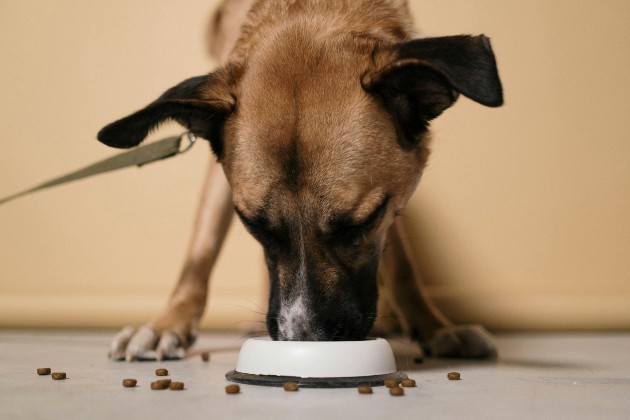
DogFoodAdvisor is reader supported See how
Dog Food Advisor is 100% impartial and is never paid to promote any brand. But if you buy using links on this page, we may earn a referral fee.
Determining how often to feed your dog is just as important for pet parents as deciding what to feed them, yet it can be equally confusing. But, it doesn’t need to be.
Many pet parents question if it’s ok to feed their dog once a day, or if two or three times is best.
Of course, there will be many factors including age, size, and your schedule (your time matters too) so it will depend on what suits you and your dog.
This article will discuss the difference between free feeding and scheduled feeding to help you decide when and how often you should feed your dog.
What Is Free Feeding For Dogs?
Just like it sounds, free feeding is essentially giving your dog access to food at all times of the day. It is an easy option for pet parents as they can just top up the bowl whenever it’s getting empty, allowing their dog to graze on food throughout the day.
What Is Scheduled Feeding For Dogs?
Scheduled feeding has more structure. A pet parent will set down a bowl of measured food for a short period and remove it whether the food has been eaten or not. Usually, scheduled feeding is one feed in the morning and one in the evening.
Should I leave Food Out For My Dog All The Time?
Free feeding can be easier for some pet parents as it requires less effort and less knowledge of nutritional requirements and serving sizes.
However, it is generally not the best feeding method for several reasons. These include:
- You have less control over how much your dog eats. Let’s face it, if we were lying around the house, we would probably want to snack every few minutes too. That’s why it’s best when our fridge isn’t full of goodies all the time.
- It can lead to weight gain. Many dogs aren’t good at knowing when they’re full so they won’t know when to stop. Eating continuously can eventually lead to unwanted health issues such as obesity or diabetes.
- Difficult to monitor appetite. Observing your dog’s eating habits is always a good indicator of their well-being. Free feeding can make it harder to identify changes in your dog’s food intake.
- Other pets may eat their food. If you have more than one pet, free feeding is probably not the best option. It can be difficult to tell who is eating what food and if you notice your cat getting increasingly bigger and your dog smaller, you’re in trouble!
- Food freshness: Food isn’t intended to sit out all day. Fats can oxidize, causing rancidity. This means the food sitting out becomes less appealing for pets and less nutritious.
What is the best feeding schedule for a dog?
Schedule feeding is generally the best option for most dogs. It allows you to feed your dog the proper serving size at every meal, to support a complete and balanced diet.
Not only does it allow you more control over portion size, but it’s also easier to monitor your dog’s appetite and eating habits to spot any unusual behaviors.
Scheduled feeding also provides your dog with a set routine which believe it or not, dogs love. Your dog will quickly understand when breakfast and dinner are which can prevent unwanted behaviors such as begging.
How Many Times A Day Should I Feed My Dog?
Is it ok to feed a dog once a day or Is it better to feed a dog two or three times? Well, before you create a schedule, you need to consider who your dog is.
The frequency of your dog’s meals depends on several factors, including their age, health status, and lifestyle.
Age
Just as we feed babies differently than ourselves, puppies will differ from adult dogs and senior dogs may differ again. You need to consider what life stage your dog is at and adjust their schedule accordingly. Young puppies will start by eating four-six times a day and gradually reduce this as they get older. It’s important to evaluate your dog’s breed, size, and age before narrowing down a schedule.
“Usually by the time puppies are weaned and heading to their new family, they are fed four times per day, dropping to about three times a day at four months and twice a day at six months,” says Laura Ward, DFA’s nutritionist.
“This is because of a puppy’s blood sugar levels. When they are young eating just two meals would mean that their blood sugar is dropping too low in between.
“Eating little and often means that their blood sugar is steadier throughout the day and doesn’t drop so low.”
Health
Dogs with certain health conditions, such as diabetes or gastrointestinal issues may require a specific feeding schedule prescribed by the veterinarian. It’s essential to follow their recommendations to ensure your dog’s dietary needs are met.
Lifestyle
Your dog’s activity levels and daily routine can also influence their feeding schedule. More active dogs or dogs that train may require a different kind of schedule depending on their exercise. A professional athlete, for example, is likely to have a different eating routine than the average person. If your dog is super active, consult your veterinarian or a nutritional expert about the best schedule for your dog.
What Times Should I Feed My Dog?
Although you might place your dog at the center of your universe, your time matters too. If you’re working a long shift and the only option is free feeding, this may be easier. For some people, automatic feeders work as they release a portion of food at particular times.
Most pet parents find feeding a meal before work and a meal in the evening (around 12 hours apart) works for their dog and their schedule.
Is It Cruel To Feed A Dog Once A Day?
If feeding your dog one big meal in the morning or evening suits you, this could be an option too.
“Dogs differ from cats in this respect,” says Laura. “Dogs evolved from scavengers, so healthy adult dogs can cope well with one big meal a day.
“Cats on the other hand are evolved for hunting small prey and so need small regular meals. For this reason, free feeding is seen more commonly for cats.”
Overall, it’s important to consider your needs and your do
Moving From Free Feeding To Schedule
If you’ve been free feeding your dog and think they may benefit from a more scheduled meal time, it may take some initial training. After all, your dog has to adjust to a constant source of food to set meal times.
Here are some tips to help you both with the process:
- Start by determining how much food your dog needs each day – our calculator will help.
- Split the amount into the two or three portions you plan on feeding them.
- At mealtime, set down one serving
- After 15 – 20 mins, remove the dish (with or without food). This may seem unfair but it will help reinforce that your dog needs to eat meals when served.
- After a few scheduled meals, a healthy adult dog will learn how the new schedule works and adjust to the routine.
If you have a picky eater, try a few of these methods but if you still can’t get your dog to eat or they have any health concerns, check with your vet before going any further.
Final word
The Dog Food Advisor does not accept money, gifts, samples or other incentives in exchange for special consideration in preparing our reviews.
However, we do receive a referral fee from online retailers (like Chewy or Amazon) and from sellers of perishable pet food when readers click over to their websites from ours. This helps cover the cost of operation of our free blog. Thanks for your support.
For more information, please visit our Disclaimer and Disclosure page.
Article reviewed by
Laura Ward
Pet Nutritionist
Laura studied BSc (Hons) Animal Science with an accreditation in Nutrition at the University of Nottingham, before working for eight years in the pet food and nutrition industry.




